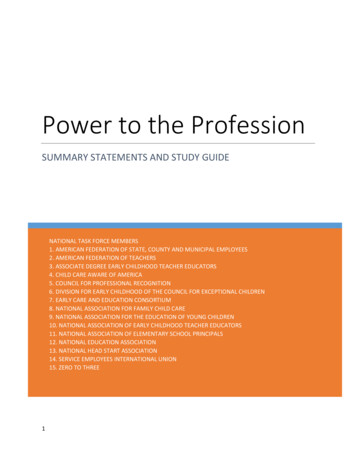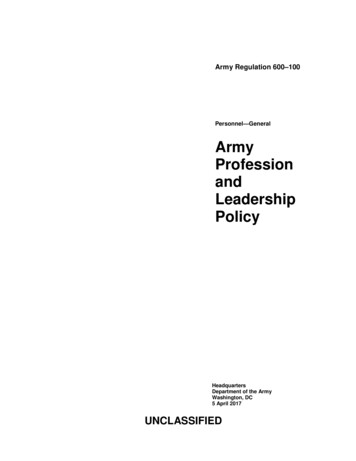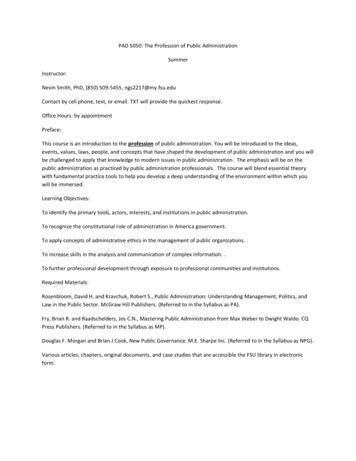
Transcription
Pursuing the Profession While Promoting the Public Good GASB 74/75The Accounting and Reporting of OPEBs IsUndergoing a Major Change2016 Health Care Summit and Benefits Fair for Local Government
What is an OPEB?Other Postemployment Benefits (or OPEB) arebenefits (other than pensions) that U.S. stateand local governments provide to their retiredemployees.These benefits principally involve health carebenefits, but also may include life insurance,disability, legal and other services.Source: GASB2
The Elephant in the Room In 2007, 1.5 trillion was the estimate ofunfunded OPEB liabilities throughout theUnited States Of that amount, Pennsylvania governments’estimate was greater than 10 billionSource: CreditSuisse3
The Problem Many OPEB plans are not funded through atrust, like pension plans “Pay‐as‐you‐go” As compared to pensions, funded through anMMO or similar payment4
Déjà vu? Governments were required to implement GASBStandards #43 and #45 beginning in 2006– These set up a liability (asset) for just the differencebetween the annual required contribution and theamount contributed Governments were required to implement GASBStandards #67 and #68 beginning in 2015– These set up a liability for the unfunded portion ofpension plans5
So Now GASB 74/75Establishes standards of accounting and financial reporting fordefined benefit OPEB and defined contribution OPEB provided toemployees of state and local governmental employersGASB 74 sets therequirements for financialstatements of the plan(if it issues separatefinancial statements)GASB 75 sets therequirements for financialstatements of thegovernment6
How the Changes in This Statement WillImprove Financial Reporting More robust disclosures of assumptions Improved transparency Better indication of the extent to which thetotal OPEB liability is covered by resourcesheld by the OPEB plan, if any Enhanced measures to evaluate decisionsrelated to contributions More consistent and conservative discountrates7
How the Changes in This Statement WillImprove Financial Reporting (continued) Streamlined calculation of actuarial present value Immediate recognition in OPEB expense for someitems, rather than a choice of recognition periods Deferral of other items over a defined, closedperiod, rather than a choice of open or closedperiods Shift of focus of the OPEB measures from theemployer’s OPEB cost to the employer’s OPEBliability8
Types of Through aTrustNotAdministeredThrough aTrust9
OPEB Plans Administered Through TrustsTo qualify as a trust:– Contributions from employers and nonemployercontributing entities to the OPEB plan and earnings onthose contributions are irrevocable– OPEB plan assets are dedicated to providing OPEB toplan members in accordance with the benefit terms– OPEB plan assets are legally protected from creditorsof employers, nonemployer contributing entities, theOPEB plan administrator, and the plan members10
OPEB Plans Administered Through Trusts(continued)The assets held in trust are subtracted from thetotal OPEB liability to determine the net PEBLiability11
OPEB Plans Not Administered Through TrustsAny assets earmarked to pay OPEB would betreated as assets of the employer and the OPEBliability would remain the total OPEB liabilityTotalOPEBLiabilityNetOPEBLiability12
Defined Benefit (DB) OPEB Plan TypesSingleAgentCost‐SharingOPEBS provided to employees ofonly ONE employerAssets are pooled in a trust forinvestment purposesAssets are pooled in a trust forinvestment purposesPrimary government andcomponent units reported togetherare considered one employerSeparate accounts are maintainedfor each employerAssets can pay the benefits for anyemployers in the planStandalone financials will have toaccount as if cost‐sharingEach employer’s assets are legallyavailable to pay only for their ownemployees13
Total OPEB LiabilityGovernments will measure total OPEB liability inthree steps:1. Projecting future benefit payments for currentand former employees and their beneficiaries2. Discounting those payments to their presentvalue3. Allocating the present value over past and futureperiods of employee service14
Actuarial Valuation The total OPEB liability generally is required tobe determined through an actuarial valuation– Valuation must occur no less frequent than every twoyears However, if fewer than 100 employees (activeand inactive) are provided with OPEB throughthe plan, use of a specified alternativemeasurement method in place of an actuarialvaluation is permitted15
Actuarial Valuation (continued) The actuarial valuation is performed as of:– The measurement date No earlier than the employer’s prior fiscal year‐end andnot later than the current fiscal year‐end Must remain consistent from period to period– A date other than the measurement date No earlier than 30 months and one day before theemployer’s most recent fiscal year‐end Rollforward procedures to the measurement date Not required to have same relationship to themeasurement date in each reporting period16
Projections of Benefit Payments Incorporatethe Effects of: Projected salary changes (if the OPEB formulaincorporates future compensation levels) Service credits (if the OPEB formulaincorporates periods of service) Automatic postemployment benefit changes,including automatic cost‐of‐living adjustments(COLAs)17
Projections of Benefit Payments Incorporatethe Effects of: (continued) (NEW) ad hoc postemployment benefitchanges (including ad hoc COLAs), if they areconsidered to be substantively automatic Certain taxes or other assessments expectedto be imposed on the benefit payments18
Discount RateOPEB plan’s long‐term expected rateof return on OPEBplan investments inthe trust To the extent the plan’s projectedfiduciary net position is sufficient topay projected benefits to currentplan membersTax‐exempt, generalobligation municipalbond rate To the extent the plan’s projectedfiduciary net position is not sufficient Where no OPEB trust exists19
Discount Rate (continued)Accordingly, underfunded plans will result in anincreased total OPEB liability compared to well‐funded plans.20
Allocation Entry age actuarial cost method is required Level percentage of pay21
Items Immediately Recognized in Expense Increases– Service cost– Interest on the totalOPEB liability as of thebeginning of the year– Administrativeexpenses– Changes in the totalOPEB liability due tochanges in planbenefits Decreases– Projected investmentreturns over the year– Current employeecontributions forOPEB– Changes in the totalOPEB liability due tochanges in planbenefits22
Items with Deferred Recognition Must use a closed 5‐year period, starting withthe current reporting period– Differences between projected investmentearnings and actual investment earnings23
Items with Deferred Recognition (continued) Must use a closed period equal to the averageexpected remaining service lives ofemployees, retirees, and vested deferredmembers, starting with the current reportingperiod– Changes in actuarial assumptions– Differences between expected actuarialexperience and actual experience24
Items with Deferred Recognition (continued) Reduction of liability in subsequent year– Employer contributions to the OPEB plan (if any)that are made subsequent to the measurementdate of the net OPEB liability and before the endof the reporting period25
Items with Deferred Recognition (continued) Reported as “deferred inflows of resources” or“deferred outflows of resources” related toOPEB26
Cost‐Sharing Employers A cost‐sharing employer’s net OPEB liability is its“proportionate share” of the cost‐sharing plan’scollective net OPEB liability The cost‐sharing plan would calculate thecollective net OPEB liability for all participatingcost‐sharing employers using the same methodsas for single‐employer and agent OPEB plans The plan would calculate the collective OPEBexpense, and collective deferred inflows/outflowsof resources27
Implementation Effective for plan financial statements for fiscalyears beginning after June 15, 2016– 6/30/17– 12/31/17 Effective for employer financial statements forfiscal years beginning after June 15, 2017– 6/30/18– 12/31/1828
Implementation (continued) Earlier application is encouraged Changes adopted should be appliedretroactively by restating financial statements,if practical, for all prior periods presented29
Pursuing the Profession While Promoting the Public Good Impact of the GASB Projecton Reporting of Fiduciary Activities2016 Health Care Summit and Benefits Fair for Local Government
Background GASB #14 was issued 25 years ago Addressed what entities are to be included inthe financial statements Also referred to “fiduciary responsibility” inthat statement 25 years later they are ready to explain what“fiduciary responsibility” is!31
Background 2002 – the GASB issues GASB Statement No.34 This significantly changed financial reportingfor governments Established current day requirements forgovernment financial reporting, includingfiduciary activities32
Business Type Activities Water/Sewer/Sanitation/Electric activitiesnormally report as “Business Type Activities”under GASB 34– User charges fund the operations – i.e., “business‐type”– Single strip presentation of the entity in the financialstatements for operations– True whether the activities are included as part of amunicipality’s financial statements, or a stand‐aloneAuthority financial statements33
General Governments Other types of governmental entities includePension and OPEB Trust Funds activity as partof their financial statements– Counties– Cities– Townships and Boroughs– Etc.34
Stand Alone Business Type Activities “Stand alone business‐type activities” (i.e.,most authorities in PA) do not include thePension Trust Funds in their FinancialStatements Why? GASB (as of today) says not to.35
Stand Alone Business Type Activities But it looks like this will change “Preliminary Views” document issued by GASBstates: Details may change, but a “preliminary view”almost always becomes a GASB Statement36
Comments The AICPA came out strongly against this view Think that including this information as afinancial fund gives users the impression thenet position in the Trust is available for use tothe general government Had the same view on GASB 34 when it cameout Prefer it to be just a note disclosure37
How Does This Impact an Authority? Most common example? Pension and OPEB Trust Funds– Is your plan a defined benefit plan?– Or a defined contribution plan? We’ve heard about this already, right?– Pension (GASB 67 & 68)– OPEB Trusts (GABS 74 & 75)38
When are you a Fiduciary? Control assets from a pass through grant– Only when the local governmentt does not haveadministrative or direct financial involvement Control assets through a trust agreement inwhich the government is not the beneficiary Control assets for the benefit of individualsthat are not citizens, and other organizationsthat are not part of your financial reportingentity39
When do I “Control Assets”? Overarching concept of control:– When you as the government can make decisionsabout: The types of assets held Assign the responsibility for those decisions Reassign the responsibility for those decisions40
Control & Administrative Responsibility41
Control Over Assets42
Decision Tree43
Decision Tree for Pension/OPEB44
Pension Trust Funds Example ‐ Pension Trust Funds Most of the information is now in yourfootnotes– Required last year under GASB 68– Would just add a financial statement for thePension Trust (and OPEB Trust) Balance sheet and income statement45
Component Units The primary government would include thecomponent unit, and its component units thatare fiduciary in nature Example:– County with a nursing home component unit– The nursing home has OPEBs– The trust would now be reported on both theCounty and the Nursing Home financialstatements46
Trust Agreements Proposed method would classify fiduciaryactivities based in part on the existence of atrust agreement A new fund type is proposed to report anyfiduciary activity NOT administered through atrust– Custodial Fund– Would include agency funds, and those for whichthere is no formal trust established47
Custodial Fund Would include:– Funds previously classified as agency funds Ex: taxes held for other governments– Funds held for pension and OPEB purposes, whichthere is no formal trust established– Certain investment and private‐purpose trustfunds with no trust agreement48
Current status Comment period ended March 2016 Redeliberations began in May 2016 Plan to issue a final GASB Statement inDecember 2016 Most likely would not be applied until June 30,2018 Financial Statements, at the earliest49
What Should I Take From This? Focus by regulatory agencies on ALL types ofpensions Focus on fiduciary responsibility/management– Monitoring of pension investments– Investment policies– Oversight of pension benefit processor A lot more work for everyone involved!50
Questions? Contact Us!Timothy J. Morgus, CPA, CFE, CGFMBrian T. McCall, CPA, �5502BMcCall@md‐cpas.com412‐535‐554051
OPEB plan's long‐ term expected rate of return on OPEB plan investments in the trust To the extent the plan's projected fiduciary net position is not sufficient Where no OPEB trust exists Tax‐exempt, general obligation municipal bond rate 19










